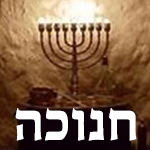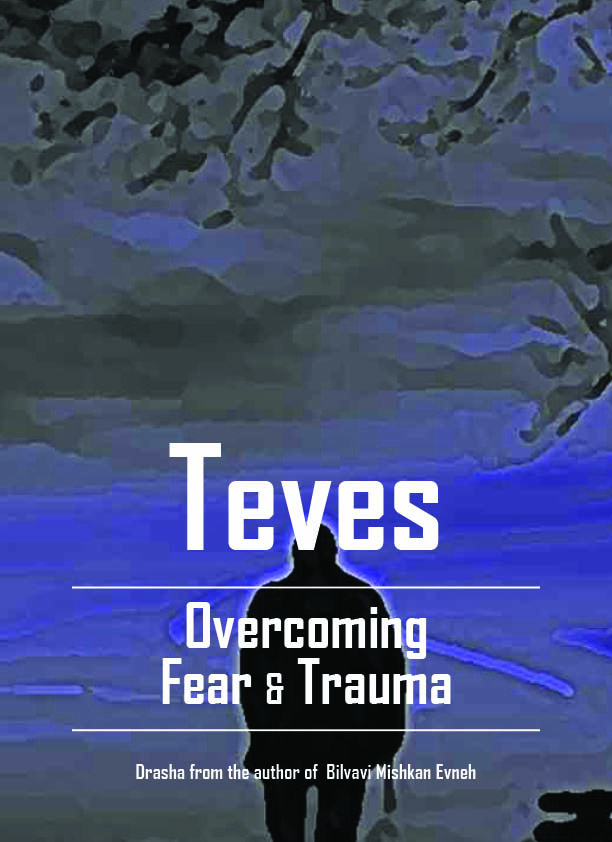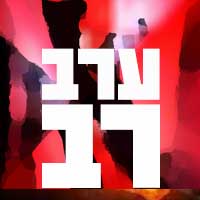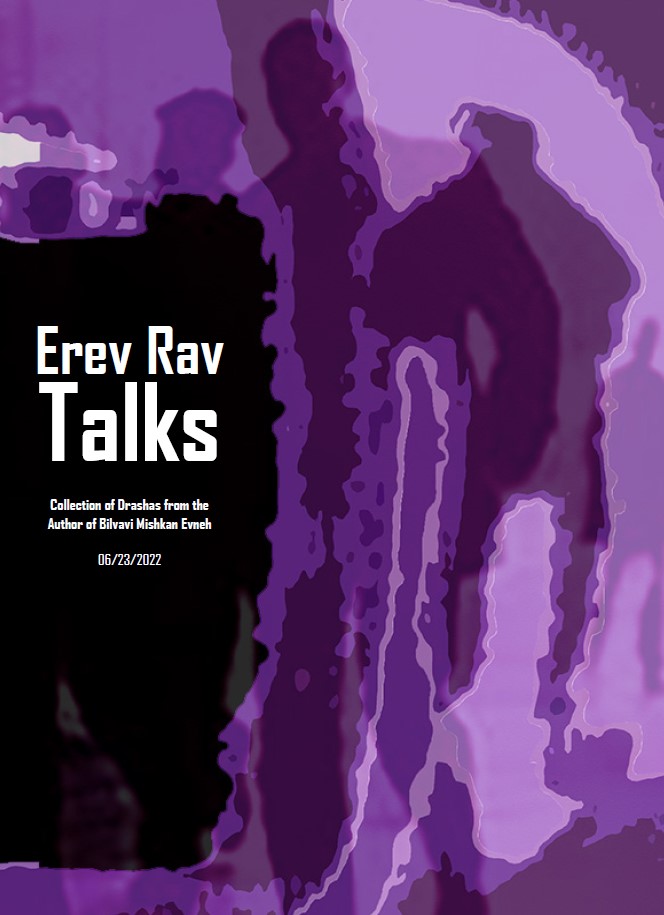- להאזנה סוכות 004 ולמקנהו עשה
004 Revelation of Nothingness
- להאזנה סוכות 004 ולמקנהו עשה
Succos - 004 Revelation of Nothingness
- 6454 reads
- Printer-friendly version
- שלח דף במייל
Yaakov Avinu Constructed Sukkos: Unifying “Kayin” and “Hevel”[1]
The first time that the Torah mentions the concept of sukkos is by Yaakov Avinu. When Yaakov Avinu camped, he made for himself “sukkos”, huts; the Torah says “And for his flock, he made sukkos. Therefore, he named the place Sukkos”. Although the simple meaning of this possuk in the Torah is also true, there is also an inner meaning of the possuk, as follows.
There is “flock”, and there is sukkos. When Yaakov Avinu made sukkos for his flock, he unified together the flock with sukkos. The word in the Torah for “his flock” is מקנהו (“mikneihu”), from the word קין(Kayin). The word “Kayin” is from the word kinyan, “acquisition”.
The sukkah is called a “temporary dwelling.” The Sages argued if sukkah must be a permanent dwelling or a temporary dwelling, and the halachah is like the opinion that sukkah is a temporary dwelling. It is also brought in halachah that the reason why we read the book of Koheles on Shabbos Chol HaMoed Sukkos is because Koheles tells us how vain this world is, which shows us how this world is only temporary.
We find a hint to this from the names of the two brothers Kayin and Hevel. Hevel represents the theme of Koheles, which teaches us that this world is nothing but “hevel havalim”, “vanity of vanities”. The concept of Sukkos parallels Hevel\Koheles, whereas the concept of “mikneihu” parallels Kayin.
When Yaakov constructed sukkos for his flock, he was essentially rectifying Kayin’s sin of murdering Hevel. There was a disparity formed between Kayin and Hevel, (and soon we will explain what it was), and Yaakov’s act of building the sukkah came to rectify that disparity. How? He made the sukkah for his flock, but in addition to this, his flock became integrated and enjoined with the sukkah that covered them.
Thus, on an esoteric level, “Hevel” serves Kayin, and “Kayin” becomes integrated and enjoined with Hevel - and then Kayin and Hevel become unified.
Kayin\Yeish and Hevel\Ayin
Let us explain the roots of disparity that were formed between Kayin and Hevel.
It is explained in the writings of the Arizal that part of Adam’s soul was given to Kayin, and part of Adam’s soul was given to Hevel.[2] In terms of our soul and of our personal task on this world,[3] “Kayin” refers to our “acquisitions”, or the physical dimension, known as “Yeish”, which we can grab onto, perceive, and hold. “Hevel” is the exact opposite of “Kayin”: Hevel is all about seeing this physical dimension as complete nothingness, “ayin”. As Koheles said: “For it is all hevel (nothing; vain).”[4]
From the perspective that “Everything is hevel” (or “ayin”) there is no difference between human and animal, because in relation to the reality of Hashem, everything in Creation is regarded as nothing. But from the perspective of yeish, there is a difference: a person is a person, and an animal is an animal; a person has daas (mental capabilities), whereas an animal has no daas. From the perspective of yeish, man is higher than animal. But Koheles says that since everything on this world is considered to be hevel (nothing), there is no difference between man and animal, for it is all hevel. From the perspective of ayin – or when ayin is revealed – everything is deemed as hevel.
Thus, “Kayin” is all about yeish, of tangible acquirements, of seeing reality at face value. If something cannot be tangibly sensed, from the perspective of Kayin\Yeish it is “hevel” – meaning, non-existent.
Something that is hevel cannot be tangibly felt. The exhale of air that leaves the body is called hevel. There are actually two levels of hevel. One kind of hevel relates to the worth of something: If it is important, if it is not so important, etc. This is the external use of the power of hevel. The inner use of hevel is when we are describing a concept that cannot be tangibly felt. Thus, there is a power of hevel that relates to This World, and there is a higher use of the power of hevel, which is transcendant
Hevel is essentially the power to turn everything in this physical dimension of yeish, into ayin (nothingness). In the lower use of this power, one dismisses the importance of something. By negating the worth of something, the hevel turns it from yeish into ayin. This use of hevel is used in the negative sense: to negate the worth of something. But in the higher use of the power of hevel, the use of hevel reveals the ayin in something, which is the true and inner view towards reality [when we uncover the inner dimension in this physical reality, which is that everything is really “nothing”, in relation to the reality of Hashem].
Yeish Vs. Ayin
Ayin needs to be contained in some kind of kli (receptacle). When a person is instead involved only with Yeish, he can only deal with that is tangible, and he cannot relate to the concept of hevel\ayin, so he will not able to contain ayin.
When Kayin killed Hevel, the depth of this matter is because the perspective of “yeish” wishes to negate “ayin”. Kayin’s act of killing Hevel represents his perspective of yeish, which cannot accept the concept of ayin. The perspective of Kayin\Yeish doesn’t allow a person to listen to the inner voice of the soul which says that “everything is hevel”, and this is the depth of “killing Hevel”. A person kills “Hevel” on his own inner level when he refuses to listen to his soul’s call, which is constantly telling a person at all times: “Everything is hevel ! Ain Od Milvado (There is nothing besides for Hashem)!!”
When one pushed away the inner voice in his soul and he chooses not to hear it, he is repeating the sin of Kayin, on a personal level.
A person has physical acquisitions of this world, and he also has spiritual, otherworldly acquisitions. The most inner possession that a person has is his “I”. The soul is not willing to forego this dear “acquisition” – it is not willing to accept that even the “I” is hevel. A hint to this is that the word “I” in Hebrew is “ani”, which is the opposite arrangement of the letters in the word “ayin”. Thus, the “ani” of a person is the very antithesis to ayin.
Thus, when one considers his “I” to be an independent existence that is not subject to “hevel” – when one is unwilling to nullify his existence – this is a repeat of Kayin’s act of killing Hevel, on an inner level. The “Hevel” in our souls is essentially the inner voice of the soul that shows us how all of existence is really hevel; it tells us that all yeish must be turned into ayin. When one refuses to listen to this inner voice, this is “killing Hevel” on an inner level, for the person is refusing to nullify his yeish (physical existence) to ayin.
Adam HaRishon’s Choice
Earlier it was mentioned that the souls of Kayin and Hevel were originally part of Adam’s soul. The understanding of this is that Adam’s test was essentially that he was supposed to choose between which perspective to connect himself to: yeish, or ayin. Adam’s sin was essentially the decision to connect to yeish. In our current 6,000 year era, it is now our avodah to turn yeish into ayin. This entails a cleansing from our sins, along with suffering, which enables us to achieve bittul, self-nullification [which subsequently brings us into the realm of ayin].
Kayin received yeish that was in Adam’s soul, and Hevel received the ayin of Adam’s soul. The temptation to eat from the Eitz HaDaas was essentially the very same warring forces between Kayin (yeish) and Hevel (ayin). Before Kayin and Hevel were born, they remained as inner forces inside Adam’s soul; when it came to Adam’s test, yeish (Kayin) prevailed over ayin (Hevel) when Adam gave into eating from the Eitz HaDaas, and when it came to Kayin and Hevel, yeish prevailed over ayin when Kayin killed Hevel.
Thus, the sin of Adam and the sin of Kayin were essentially the same sin.
Sukkos: The Connecting Point Between Yeish and Ayin
Ever since the sin of Adam, yeish has prevailed over ayin. Had Adam never sinned, the souls of Kayin and Hevel would have been integrated, and it would have been revealed how everything, both yeish and ayin, are all echad (one unit) – the concept of “Ain Od Milvado”. Now that we live after the sin, the dimensions of yeish and hevel are separated and they cannot be integrated. But at the very roots and purpose of Creation, yeish and ayin are integrated into one, under the greater reality, of Ain Od Milvado.
The festival of Sukkos, though, is the point that reveals how yeish and ayin are integrated into one reality. Sukkos is connected with the word ולמקנהו, which is from the word “Kayin”, and earlier it was explained that this was because the sukkah connects Kayin with Hevel; thus sukkah is the point where Kayin\yeish becomes enjoined and integrated with Hevel\ayin.
At their very roots, Kayin and Hevel are connected in one unit. A hint to this is where the Torah says, “And they were in the field”, which shows us that there is a point where Kayin and Hevel are connected together.
Tasting of Hashem
It is written, “Taste and see that Hashem is good.”[5]We can “taste” of Hashem, so to speak. Although Hashem is incomprehensible, we can still have a “taste” of Him. The Mesillas Yesharim states that “man was not created except to delight in Hashem and enjoy the radiance of His Shechinah.” After Adam sinned, we lost the spiritual pleasure, the oneg, of basking in Hashem’s Presence, and instead our sense for pleasure was replaced with evil and unspiritual pleasures. But at its very root, our power of taste (which was abused to sin with eating from the Eitz HaDaas) is the tool with which we can taste of Hashem.
When we “taste” the spiritual dimension, ayin, we lose our taste in yeish; when we taste of bittul (self-nullification), we lose our taste for the tangible and the comprehensible.
The true taste is experienced when we “taste” of the Creator. This is the depth behind the four species.
In the four species, we bind together a species that has taste and no scent (hadasim), a species that has a scent and no taste (lulav), a species that has a taste and a scent (esrog), and a species that has no taste and no scent (aravos). All of these aspects become combined and integrated with each other, when we bind together the four species. The matter of aravos is troubling: if aravos have no taste and no scent, why do we take them? Why don’t we instead take only a species that has either taste or scent?
But this is not a question, because the understanding of the four species is totally different than this. The Baal Shem Tov explained that the absence of the taste and scent in the aravos is really an example of ayin – in other words, “ayin” is the taste and scent of the aravos.
This is the secret behind the aravos. As long as a person hasn’t yet connected himself to the point of ayin, then indeed, he will not find any taste or scent in the aravos. But when a person becomes connected to ayin, he will then find that ayin is the taste and scent of the aravos.
And this is essentially what gives a person the ability to connect together the four species and integrate them.
Hoshanah Rabbah – The “Seal Within A Seal”: The Shattering of Limitations
There is a secret depth behind why we bang the aravos\hoshanos on the seventh day of Sukkos (Hoshanah Rabbah). It is really a matter which needs understanding: why do we set aside a special day on Sukkos to awaken mercy that we receive rain, and why we do we specifically use the willow branch, which is the species that represents the wicked, who have no taste (Torah) and no scent (mitzvos)?
But the depth is as follows. The fact that the aravos have no taste and no scent is but the external aspect of the aravos. The inner dimension of aravos is that their absence of taste and scent is, itself, the very taste and scent of the aravos!
When we pray for mercy on our water on Hoshanah Rabbah, we are referring to the original waters that were created on the first day of Creation, where there was nothing but “the spirit of G-d” that hovered over the face of the waters.” The Sages say that the “spirit of G-d” here refers to “the spirit of Mashiach”.[6] These were the waters of the spiritual dimension (“ayin”) and not of the physical dimension (“yeish”). And it is precisely the aravos which awaken the original waters of Creation, for the aravos have no taste and no scent, thus they contain “nothingness”, which is the key to the spiritual dimension. Its nothingness, (“ayin”) is essentially its taste and its scent.
This is the secret that lies behind the words of the Arizal[7] that there is a piska tava (good message) given over on Hoshanah Rabbah which takes effect on Shemini Atzeres\Simchas Torah. The piska tava is essentially the external layer of the seal, whereas the seal that was signed on Yom Kippur is the inner seal. Together, the seal of Hoshanah Rabbah and the seal of Yom Kippur form the chotam b’toch chotam, the “seal within a seal”. The seal represents a boundary, a limit, for the word chosam is from the word techum, “boundary”. On Hoshanah Rabbah, where the dimension of ayin is revealed, all boundaries become integrated with the limitless dimension.
Thus, the chotam b’toch chotam is essentially the point where boundaries are nullified. When the boundaries are nullified, when limitations are shattered, we can then taste and smell the dimension of ayin [which we cannot taste and smell with our physical senses]. And then we can merit a “chasimah tovah” – a “good signature”.
When we perceive the seal of Yom Kippur as a limitation that cannot be broken, that itself awakens judgment upon ourselves. But when our physical dimension (yeish) joins with the spiritual dimension (ayin), when our limited dimension merges with the limitless dimension, we are then able to truly have a “piska tava”.
Shemini Atzeres and Simchas Torah: Two Dimensions Joining Each Other
This concept continues into Shemini Atzeres\Simchas Torah, of which “the end is contained in the beginning”[8]; the finishing of the Torah, which commences with beginning the Torah.
The finishing of the Torah represents our limited dimension. From this viewpoint, the Torah is referred to as “Toras emes”, “the Torah of truth”, and the “seal of HaKadosh Baruch Hu is truth” – which means that we are confined to certain limitations. But when we consider the concept of “the end is contained in the beginning” – the fact that as soon as we finish the Torah, we begin the Torah – this reveals to us the concept that the limitless dimension beyond our own time and space can pour into our own limited dimension. This point is known as “emes l’amitah”, the absolute level of truth – and this is the point that describes the “chotam b’toch chotam” of Hoshanah Rabbah.
The concept of the “piska tava”, which appears after the signature that was written and sealed during Rosh HaShanah and Yom Kippur, is essentially the point that reveals the root of the chotam b’toch chotam; it is the point of hiskalelus (integrating) with Hashem.
The “seal of HaKadosh Baruch Hu is truth”; when we reveal the point of emes l’amitah (absolute truth), we see that there are levels to the truth, and that not all truth is the absolute truth. What is emes\truth, and what is emes l’amitah\absolute truth? The limited dimension we normally are contained in is a truthful dimension, but there is a more inner dimension that is beyond it, where there are no limitations; that is the emes l’amitah.
Thus, our limited dimension we are normally in is not the emes l’amitah, although it is certainly emes. The emes l’amitah is the point where the limitless dimension meets with our own limited dimension and it is shined upon it.
This is the secret of the “chotam b’toch chotam”. The “seal of HaKadosh Baruch Hu”, which is essentially the chotam b’toch chotam, is the emes l’amitah. It is the point where the limitless dimension is revealed upon our own limited dimension, and this is how what the chotam b’toch chotam accomplishes. It shows us that our own limited world is ultimately a part of a higher, limitless dimension, which shows us that there is more to the truth that we see. It is because we really do not understand the truth at all, for all truth is ultimately bound up with Hashem, and “no thoughts can comprehend Him”.[9]
This is the depth that is behind these 22 days of Tishrei that spans Rosh HaShanah through Shemini Atzeres. Since Rosh HaShanah, we are being drawn closer to HaKadosh Baruch Hu’s embrace[10]. But Succos is the time where we actually become integrated (miskalel) in Hashem, for the sukkah is where we sit in the tzeil (shadow) of Hashem. It is the point of ayin, which we cannot grasp or comprehend in any way; it cannot be physically sensed.
The secret of these days is that they reveal to us the concept of hiskalelus in Hashem, where we can see that everything is really ayin (nothingness), and as Shlomo HaMelech says in Koheles: “For everything is hevel (nothing).” And when ayin becomes integrated with the Creator, it is revealed the depth of “Ain Od Milvado” – that there is nothing besides for Hashem.
[1] This translation is a summary of a derasha printed in sefer Bilvavi Mishkan Evneh – Sukkos (pages 27-38), and the bulk of it is takenfrom pages 27-30 and pages 37-38.
[2] Note from the Hebrew sefer: The concept of the souls of Kayin and Hevel is a deep and broad matter which is spread out and discussed throughout the writings of the Arizal, and it requires many introductions to explain it; and not every mind can understand the concepts. Refer to Sefer HaGilgulim, 21-23.
[4] Koheles 3:19
[5] Tehillim 34:9
[6] Beraishis Rabbah 2:4
[7] Shaar HaKavanos: Sukkos, derush 6
[8] Sefer Yetzirah 1:6
[9] P’sach Eliyahu
[10] Arizal: Shaar HaKavanos: Yom Kippur, derush 4
NOTE: Final english versions are only found in the Rav's printed seforim »













